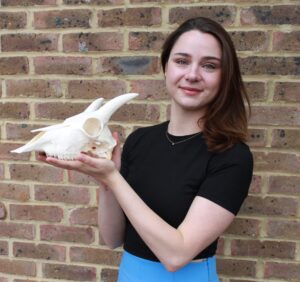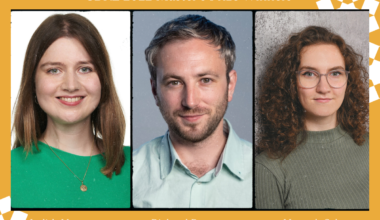We are thrilled to announce the winners of the 2023 annual Levant Summer Prizes!
Launched in 2022, CBRL’s international peer-reviewed journal Levant offers two annual prizes for Best Paper and Early Career Best Paper, which aim to recognise excellent research and scholarship on the archaeology and history of the Levant region, its diasporas and neighbouring countries (prehistory — Ottoman). For the aims and scope of the journal, please see here.
The Best Paper award has been awarded to Kent D. Fowler, for his paper Age and sex determination of fingerprints on ceramic objects from the Late Bronze Age palace at Tel Beth-Shemesh, co-written with Jon Ross, Christian Barritt-Cleary, Zvi Lederman, Shlomo Bunimovitz & Haskel J. Greenfield.
The judges thought that this paper was an elegant and well contextualised study that presented new and novel data with a rigorous and well researched methodology indicating that men, women, adolescents and children all left prints on the assemblage. A very attractive and well written case study likely to be widely cited in studies of childhood, analysis of ‘toys’ etc.
Kent Fowler, winner of the Best Paper award, commented:
Our paper examined fingerprints on figurines and a lamp associated with feasting equipment from a room in the LBA palace at Beth Shemesh. Our aim was to estimate the age and determine the sex of the printmakers. We found that children and adults and adolescents of both sexes made the prints on the objects. The results provide new insights into how the objects were made and the role of children in Canaanite society. We argued that the objects held meaning as both toys and ritual items, and that children were included in public, elite activities, like feasting.
The Early Career Best Paper has been awarded to Gwendoline Maurer for her paper Cattle drivers from the north? Animal economy of a diasporic Kura-Araxes community at Tel Bet Yerah, co-written with Raphael Greenberg.
The judges thought that this paper contributed new ideas and data to both its sub-field/specialist area, as well as archaeological scholarship in general, and that the research questions explored and methodologies employed were compelling and robust, with an in-depth discussion of the significance of the findings.
Gwendoline Maurer, winner of the Early Career Best Paper, commented, “I am very honoured to have been awarded the 2023 Levant Summer Prize, Early Career Best Paper. I hereby take the opportunity to express my gratitude to all archaeologists, researchers and collaborators in the Levant and Caucasus who have so generously supported me throughout my career and made it possible for me to travel and work on these materials throughout the years as well as shared their deep understanding of the region with me.”
Below are the abstracts of the winning papers:
Age and sex determination of fingerprints on ceramic objects from the Late Bronze Age palace at Tel Beth-Shemesh by Kent D. Fowler, Jon Ross, Christian Barritt-Cleary, Zvi Lederman, Shlomo Bunimovitz & Haskel J. Greenfield
Who made figurines for ritual feasting in the Late Bronze Age (LBA) palace at Tel Beth-Shemesh? This article attempts to answer this question by determining the age and sex of fingerprints on five zoomorphic figurines and a lamp from a unique room in the LBA IB–IIA palace that contains an assemblage normally associated with feasting. The age and sex determinations of 59 preserved epidermal print impressions, based upon the analysis of ridge breadth and ridge density, are reported. Accounting for 2–6% clay shrinkage, the results show that at each respective rate, 37–46% of the prints were made by adults, 46–53% by adults or adolescents, 9–10% by children, while 51–60% were male and 49–40% were female. The discussion explores these results in relation to understanding manufacturing practices, the distinction between toys and ritual objects, and the visibility and role of children in LBA I–II society.
Cattle drivers from the north? Animal economy of a diasporic Kura-Araxes community at Tel Bet Yerah by Gwendoline Maurer & Raphael Greenberg
Kura-Araxes animal management strategies in the core regions of the tradition and in areas of its 3rd millennium expansion have seen only sporadic study. Recently excavated contexts at Tel Bet Yerah were occupied in the first part of the Early Bronze Age III (c. 2850–2700 BCE) by people using Khirbet Kerak Ware and accompanying artifacts associated with a diasporic Kura-Araxes cultural tradition; they provide a rich zooarchaeological assemblage that may be contrasted with that of the local Levantine population, underscoring social and cultural distinctions maintained by the diasporic community. Focusing on the cattle assemblages in Kura-Araxes sites, their use for traction and transport is explored, as well as their role in maintaining cultural identity.
About the winners:

Kent D. Fowler (PhD, Alberta) is Associate Professor in Anthropology, Senior Fellow of St. John’s College, and Faculty of Arts Social Science Research Professor at the University of Manitoba (Winnipeg, Canada). He is an anthropological archaeologist with research interests in the development of early farming societies and pre-industrial states. His research in archaeology, ethnoarchaeology, ethnohistory and experimental archaeology has largely focused on clay technologies and the organisation of crafts production in Europe, Africa, and Canada. He is currently leading two research projects: one in South Africa on the on the growth and collapse of precolonial states, and a second examining epidermal ridge skin impressions on archaeological objects.
 Gwendoline Maurer is a PhD student at the UCL Institute of Archaeology, UK. She previously obtained a BA in Archaeology and Anthropology and a MSc in Environmental Archaeology from the UCL Institute of Archaeology, UK. In September 2023, Gwen will be joining the University of Reading, UK as a Post-doctoral researcher on the MENTICA Project (Middle East Neolithic Transition — Integrated Community Approaches).
Gwendoline Maurer is a PhD student at the UCL Institute of Archaeology, UK. She previously obtained a BA in Archaeology and Anthropology and a MSc in Environmental Archaeology from the UCL Institute of Archaeology, UK. In September 2023, Gwen will be joining the University of Reading, UK as a Post-doctoral researcher on the MENTICA Project (Middle East Neolithic Transition — Integrated Community Approaches).















